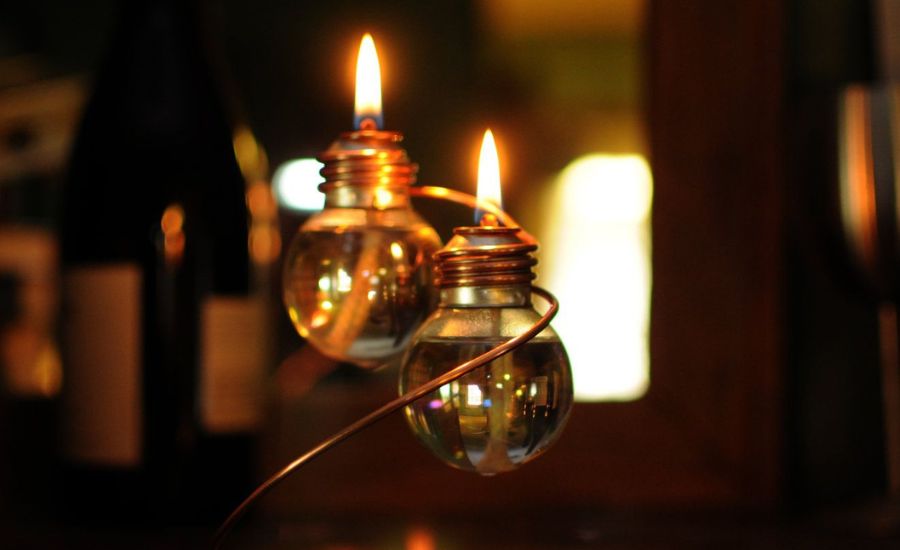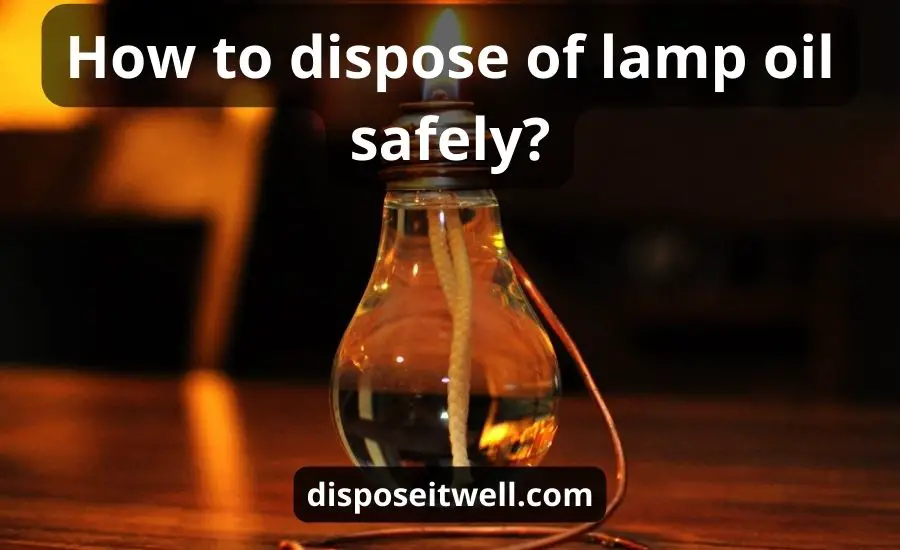The rapidly growing threats to ecological sustainability, such as water and air pollution, highlight the issue of harmful waste management.
In our article, we’ll give some pieces of advice on how to dispose of lamp oil.
We’ve decided to start our discussion on how to dispose of lamp oil properly and safely with the definition of lamp oil and a description of possible options for its use.

Lamp oil: definition, composition and purposes
Lamp oil is a flammable petroleum-based liquid used as a fuel for such lighting fixtures as lamps and torches. Sometimes, the oil lamps are called ‘kerosene lamps’ due to their similar purpose but not the quality of the fuel.
Thanks to purification, lamp oil, as compared with kerosene, emits significantly fewer fumes, odor, and smoke.
In addition, vegetable oil derived from certain plants can be used as an alternative lamp fuel.
The oil lamps are suitable for use indoors and outdoors due to the long time of their burning as compared to other light sources, for example, candles.
Some people think that oil lamps are far back in the past. However, they remain very popular and not only for decorative purposes. They may be used for various practical purposes.
Lamp oil remains a very popular fuel for laboratory burners. It is our ‘magic bullet’ during nature hikes, or in case of power outage. Just think, what should we do in extraordinary situations when, for example, battery-powered lanterns are not available?
Recommendations on the proper disposing of lamp oils
The first thing to be kept in mind is the high flammability of oil which requires careful handling to ensure the safety of the processes.
In addition, handling dangerous materials is not a game. Therefore, a responsible attitude to all safety recommendations is another key to success
Safety considerations
Indoor use requires increased caution. Remember that it is highly flammable. It is not allowed to keep the used lamp oil together with other waste in a regular trash bin.
Lamp oil is composed of hazardous chemicals. It is very dangerous to store them in places exposed to heat sources.
It is strictly prohibited to pour lamp oil into a landfill. It will contaminate the environment and pollute groundwater. For the same reasons, it is not allowed to sewer the used lamp oil.
This can clog the drainage pipes or, ultimately, can penetrate the soil or sources of water supply.
Mixing the oil waste with other liquid wastes can lead to dangerous consequences. All household chemicals should be disposed of separately. Chemicals can react and cause an ignition. Also, it is not allowed to mix lamp oils with different compositions.
Like the majority of chemicals, lamp fuel can become a poison when ingested. It is especially dangerous for your respiratory organs. The oil drops falling on your skin can cause burns. Protect eyes from the oil splashes: wear protective glasses.
Strictly comply with the rules and standards prescribed by a local waste management authority. The above doesn’t present a complete list of safety precautions. However, we’ll add it in the sections below describing the proper disposal of lamp oil.

Algorithm of the disposal procedure
The principles and algorithm of lamp oil disposal are similar to any hazardous waste disposal. Below we present the key factors of the process.
Preparation stage
Never start to work if your lamp is still burning. After complete cooling of the lamp, remove a wick. Gently twist it to get rid of excess oil.
Fill an original lamp oil container, if available, with the used lamp oil directing a flow by a suitable funnel.
To remove all used oil residues wipe all contaminated surfaces with a soft cloth. If the wick is worn and can’t be reused, pack it in a plastic bag.
Inspection of remaining oil
Check the unused lamp oil to determine the possibility of its reuse. The appearance of such signs as a change of color or odor indicates the oil spoilage. The reuse of such oil is harmful to your health. Along with the quality, the approximate volume and weight of oil should be assessed.
How to dispose of lamp oil at home?
If the volume of unused oil prepared for use is not large, you can dispose of lamp oil by yourself, unless it is prohibited by local regulations, standards, and laws.
If you decide to dispose of lamp oil at home, read the relevant instructions and don’t neglect the safety precautions described above.
Upon removing the leftover content from the oil lamp, pour the unused lamp oil into a suitable reservoir, then add an absorbing material, for example, sawdust or shredded paper, to obtain a solid mixture. Sealingly pack the obtained mass and locate it in a trash bin.
Otherwise, this is not the case with a significant volume of the used lamp oil. Under applicable local regulations, you should mandatorily contact the local waste management body to receive professional support.
In any case, you should carefully read the local regulations on lamp oil disposal to avoid penalties for improper disposal of household hazardous waste.
Transportation of lamp oil to a dedicated waste recycling site
The environmental regulations of the authorized bodies may differ from each other. Nevertheless, they are uniform in the key requirements.
Lamp oil should be transported in a securely closed reservoir. The best option is a sealed metal container intended specifically for the transportation of hazardous materials.
If the container is not closed as required, the occurrence of leaks is possible. The lamp oil container should be labeled with the ‘Lamp oil’ or ‘Hazardous material’ marking and an indication of the brand of oil, its volume, and weight.
A few useful pieces of advice on how to dispose of lamp oil
Lamp oil should be cooled completely. Hot spills and leaks of oil can cause sensitive burns. A method you select to dispose of lamp oil shouldn’t cause harm to the environment and human health. Take all preventive measures against accidental ignition.
To safely dispose of lamp oil, it is strictly recommended not to mix different lamp oil types. This can create hazardous fumes and cause the risk of environmental pollution.
Keep the receipts and other papers with the records of disposal for submission to a local authority, if required.
Before applying to an authorized body responsible for hazardous waste disposal, collect the complete data on the lamp oil you want to dispose of. This shall include an indication of type or brand, volume, and weight.
Lamp oil recycling and reusing
If you decide to recycle and reuse lamp oil in dedicated organizations, it will be an essential contribution to environmental safety.
Lamp oil is considered to be a nonrenewable material. However, currently, there are many facilities and companies ready to collect and recycle lamp oil.
The used lamp oil recycling is an advanced eco-friendly technology used to reduce waste and environmental pollution.
Recommended procedure for storage of lamp oil
The issues related to storing lamp oil are not less critical than the issues concerning its proper and safe disposal.
Proper sealing of a container ensures the safe storage of lamp oil. Select a dry location for storage.
The storage at room temperature is preferable. Storing the lamp oil containers close to heat sources can lead to a fire and other negative consequences.
Exclude any possibility of access to children and pets.
Storage of lamp oil in reservoirs with precisely fitted caps will ensure its long lifespan and bring evaporation to a minimum.

Final thoughts
As far as lamp oil is a fuel it is classified as hazardous waste and is subject to all rules and regulations applicable to hazardous waste management. Therefore, lamp oil should be treated and disposed of as a household hazardous waste.
The most critical condition is a responsible attitude to all requirements for storing and recycling lamp oil safely, in strict compliance with the applicable laws, standards, and regulations.
Improper disposal or failure to safely dispose of lamp oil, as well as violation of rules for storing lamp oil, is fraught with dangerous consequences for the environment, and, accordingly, for human safety and health.
We hope that our article has managed to present detailed recommendations that will help you to handle and dispose of lamp oil properly.
FAQs
Is lamp oil hazardous?
Lamp oil is a flammable liquid and can be hazardous in case of improper handling. As for its toxic characteristics, the lamp oil is hazardous for the respiratory system if ingested.
Will lamp oil evaporate?
In case of exposure to open air, the lamp oil can evaporate. To minimize the lamp oil evaporation and preserve its quality, it is necessary to store it at normal temperature in a sealed container.
How do you properly dispose of oil?
To dispose of the oil properly, you should pour the cooled oil into a tightly closed metal container. It isn’t allowed to keep a container with used lamp oil in a trash container intended for ordinary domestic trash.
If a large quantity of lamp oil is subject to disposal, the best way is to contact a local waste management facility.
Does lamp oil go bad?
Lamp oil is subject to quality deterioration over time. Such signs as sediments, change of color, or odor indicate that lamp oil has gone bad.


1 thought on “Top 6 Recommendations on how to dispose of lamp oil safely”
Comments are closed.